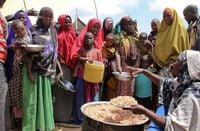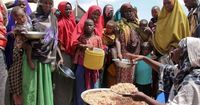The United Nations World Food Programme (WFP) has announced a dramatic reduction in food assistance for Somalia, leaving hundreds of thousands of people at risk as the country grapples with a perfect storm of climate disasters, conflict, and shrinking international support. The cut, revealed on October 3, 2025, will see food aid recipients drop from 1.1 million in August to just 350,000 by November—a staggering 750,000 fewer people receiving help at a time of deepening hunger.
According to the Associated Press, this move comes as the WFP faces what it calls "critical funding shortfalls." The agency, which has long served as a lifeline for Somalia’s most vulnerable, warns the consequences could be dire. "We are seeing a dangerous rise in emergency levels of hunger, and our ability to respond is shrinking by the day," said Ross Smith, WFP’s director of emergency preparedness and response. He added, "Without urgent funding, families already pushed to the edge will be left with nothing at a time when they need it most."
Somalia’s food crisis is rooted in a complex web of challenges. The latest U.N. report, cited by AP, paints a grim picture: 4.6 million people in Somalia are now facing crisis levels of hunger. The situation is particularly dire for children—1.8 million are projected to suffer from acute malnutrition this year alone, with 421,000 of them at risk of severe malnutrition. The WFP has only managed to assist about 180,000 of these children so far in 2025, underscoring the immense gap between need and available support.
What’s driving this escalating crisis? Climate change is striking Somalia with full force, bringing both drought and flooding, sometimes in rapid succession. These extreme weather events devastate crops, kill livestock, and destroy livelihoods, making it nearly impossible for families to recover before the next disaster hits. According to the BBC and other international outlets, Somalia’s vulnerability to climate shocks is compounded by decades of conflict and insecurity. The al-Qaida-linked militant group al-Shabab still controls significant swathes of the country, limiting humanitarian access and destabilizing communities.
The funding crunch, however, is the most immediate threat. The WFP’s decision to slash aid is rooted in a dramatic drop in donations from key international partners. Aid officials have pointed directly to reductions in U.S. foreign aid as a major factor. As reported by Conflingo.com, these cuts have further strained the ability of humanitarian groups to meet the growing needs of Somalia’s population. The WFP itself says it needs an additional $98 million just to "sustain a minimum of life-saving operations for 800,000 people through the lean season until March 2026." Without this funding, the agency warns, the already bleak outlook could become catastrophic.
For those on the ground, this isn’t just a matter of statistics—it’s a daily struggle for survival. Humanitarian workers in Somalia describe seeing families forced to make impossible choices, skipping meals or selling what little they have to buy food. With the WFP’s capacity shrinking, many worry that the most vulnerable—especially children—will be left with no safety net.
Ross Smith, speaking on behalf of the WFP, didn’t mince words: "We are seeing a dangerous rise in emergency levels of hunger, and our ability to respond is shrinking by the day." His warning is echoed by aid groups across the region, who say that without immediate and substantial new funding, the humanitarian crisis in Somalia could spiral even further out of control.
The numbers are stark. In August 2025, the WFP was able to reach 1.1 million people with food aid. By November, that number will plummet to just 350,000. The agency’s latest appeal for $98 million aims to keep at least 800,000 people from falling deeper into hunger during the upcoming lean season, which lasts until March 2026. But as of early October, the response from international donors has been tepid at best.
What’s behind the decline in donor support? According to multiple sources, including the U.N. and AP, shifting priorities among Western governments and a global economic slowdown have led to tough choices about where and how to allocate limited humanitarian funds. The United States, historically the largest donor to the WFP, has reduced its contributions, forcing the agency to make painful decisions about which programs to cut. Other donors, facing their own domestic pressures, have also scaled back.
The impact is being felt most acutely by those who can least afford it. The U.N. estimates that more than 4.6 million Somalis are now in crisis-level hunger, with 1.8 million children at risk of acute malnutrition. Of these, 421,000 children face the most severe forms of malnutrition, and the WFP has only been able to assist about 180,000 so far this year. The gap is widening, not closing.
Somalia’s crisis is not occurring in a vacuum. The country has long been at the intersection of conflict, climate, and chronic poverty. The presence of al-Shabab, which controls large areas of the country, makes it difficult for aid agencies to reach those most in need. Ongoing violence and insecurity force families from their homes, disrupt markets, and prevent farmers from planting or harvesting crops. Add to that the unpredictable swings between drought and flood, and it’s no wonder that so many are teetering on the edge of disaster.
International observers warn that the current funding shortfall could have ripple effects beyond Somalia’s borders. As hunger deepens, more people may be forced to flee their homes in search of food and safety, potentially destabilizing neighboring countries and fueling broader regional insecurity. Humanitarian groups are urging donors to step up before the situation deteriorates further.
"Without urgent funding, families already pushed to the edge will be left with nothing at a time when they need it most," Ross Smith emphasized. The message is clear: the clock is ticking, and the window to prevent a full-blown catastrophe is closing fast.
The WFP’s appeal for $98 million is not just a plea for charity—it’s a call to action to prevent a preventable disaster. Aid officials say that with timely support, it’s still possible to avert the worst outcomes. But every day that passes without new funding means more families slip through the cracks.
The world’s attention may be elsewhere, but for millions in Somalia, the stakes couldn’t be higher. As the lean season approaches and food stocks dwindle, the need for urgent action has never been greater. The question now is whether the international community will answer the call—or whether Somalia’s most vulnerable will be left to face hunger alone.
With the WFP’s warning ringing in the air and the numbers growing more dire by the day, the fate of hundreds of thousands hangs in the balance. The coming weeks will reveal whether the world is willing to act—or willing to look away.

